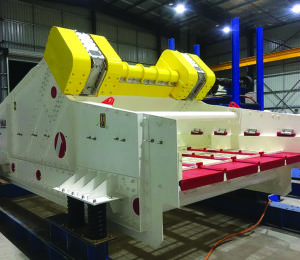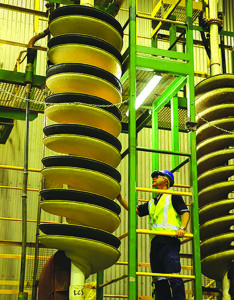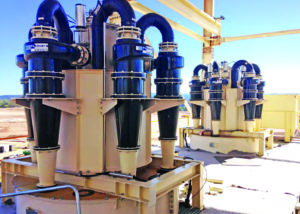The fine coal DMC circuit emerges as a possible game changer
by steve fiscor, editor-in-chief
The cutting and grinding action of mining and crushing coal generates fines. Those fines can be a nuisance or a money maker, depending on the quality of the coal bed and the market the mine serves. While steam coal producers may opt to discard ultra-fines, coking coal operators would like to cover as much coal as possible from that stream.
To find out what’s happening in the marketplace, Coal Age spoke with Peter Bethell, senior principal for mineral processing with Marshall Miller & Associates. He has been working on several projects in Australia, Canada and South Africa and assisting with new and existing coking coal plants in the U.S.

Aury manufactures banana screens with single and double decks from 1.8 m x 4.8 m up to 4.8 m wide and 8.5 m long.
Bethell noted several trends in the coal preparation business, including efforts to drive costs down as far as possible, more use of wear-resistant materials, improvements in plant construction and equipment design, and lower equipment costs.
Plants are moving toward more single unit operations with more automation. They have been investing in ceramics for cyclones, chute work and other high-wear areas. Screen designs have been improving steadily with wider, higher capacities and now more wear-resistant media. “All these things are falling into place to hold costs down and make the plants more reliable,” Bethell said.
The costs for some equipment like filter presses, cyclones and screens have been reduced thanks in large part to either Chinese competitors entering the market or traditional suppliers outsourcing manufacturing to India and China. Bethell cited the Jinjing filter press as an example of a Chinese filter that is working its way into U.S. operations. “Tons Per Hour sells an Americanized version of the Jinjing filter press,” Bethell said. “Aury, another Chinese company, recently entered the screening market.” These Chinese companies and others have such a large installed base of processing equipment in China that their learning curve on equipment design continues to advance.
“The other major thrust is an attempt to achieve lower density separation in the plants,” Bethell said. “Many of the resources that are available worldwide today are higher in ash, higher in sulfur and lower in coking characteristics. To produce a decent-quality coking coal, the plant needs to make lower density cuts, which means they must find different ways to treat fine coal to attain an acceptable yield.” The other challenge is finding a way to process the ultra fine stream (minus 100 mesh or minus 150 microns), and find ways to dewater and recover the coal.
Lowering the Density Separation
Low-density separation techniques are the big driver in fine coal recovery for met coal producers worldwide, Bethell explained. “Traditionally, in the last 30 years, spiral circuits would make a cut point in the 1.7-1.8 range, which means incrementally 35% ash material would report to the product stream,” Bethell said. “That’s fine if the overall cut point for the plant is 1.55-1.60. Unfortunately, however, with reserves worldwide, the dense media cut point is in the high 1.30s, low 1.40s. The plant can’t live with separation in the fines circuit in the 1.80s because it can’t produce the needed quality. So, the major thrust lately has been to make a lower cut with the fines circuit or 1 mm x 60 mesh.”
There are three ways to make a lower cut in the fines circuit: the use of a teetered-bed separator (TBS) or a REFLUX Classifier (RC), low-density spiral concentrators or a fine dense-media-cyclone (DMC) circuit.
The TBS and the RC can achieve a 1.46-1.75 cut without too much problem, but they have some constraints and operational issues, Bethell explained. “A TBS or an RC circuit works well over a narrow size range, like 4:1 or 1 mm x 0.25 mm,” Bethell said. It’s very efficient if its well-controlled. If oversize material enters, they lose coal to the refuse stream and if they are loaded with fines, more impurities will report to the product stream. The operators need to control the fluidizing water and density on these units. They need a lot more attention and input than the other systems and that probably explains why they are not so popular with plant operators.”
Two of the major manufacturers of spirals are Mineral Technologies and Multotec. Both have developed spirals for lower-density applications, such as Mineral Technologies’ LC3 and Multotec’s SX10. “Both will make a lower cut, but they require additional circuitry to be efficient,” Bethell said. “To make the lower cut, plant operators lose low density material to the middlings or reject streams. To make them work well, the plant will need a secondary circuit to reclean at least part of the waste stream.
“Both companies make good spirals that are easy to operate,” Bethell said. “They have a few key things to look after, but otherwise they are straightforward. The problem with the low cut point is that you must have two-stage circuits. It’s not a big deal, but the plant must buy another set of spirals and install a second pump and another sump. Spirals are forgiving over a fairly large size range. They can process 1.5 mm to 100 mesh and provide good separation with similar densities without problems.”
“To make the low-density cut, the LC3 and the SX10 have to be derated from 2.5 tph to 3 tph to less than 2 tph compared to their predecessors,” Bethell said. “Spirals with a second stage require a much larger footprint.”
The new kid on the block, Bethell explained, thanks to lots of research in China and South Africa, are the fine coal DMC circuits. “They make efficient cuts under 1.50 and take advantage of new magnetic separators,” Bethell said. “In the U.S., 30 or 40 years ago, we had several ‘by zero’ DMC circuits, but the magnetic separator technology was not that great. To make those circuits work, plant operators had to bleed a lot of media from the circuit, which led to magnetite losses and consequently didn’t attain the expected performance levels.”
The new circuits are straightforward, and the data show good efficiency at low-density cut points, Bethell said. “As far as capital equipment costs, they will be more expensive than spirals or the RC, but it’s the Cadillac of fine coal recovery systems these days,” Bethell said.

Mineral Technologies’ LC3 spiral concentrator targets a cut point of 1.45 to 1.60 with a capacity of 3.5 mtph pr start (typically 2 to 2.5 mtph/start) with a pulp density of 20% to 40%.
A typical module in South Africa processes 50 tph of fine coal (1 mm x 60 mesh) using a bank of 14-in.-dia. DMCs, which are two-staged with magnetic separators on the clean and refuse sides. “The clean coal goes one way, and the refuse goes the other way and — bingo! — you have highly efficient, low-density separation and high efficiency.”
The fine coal DMC circuit is more forgiving than the spiral concentrators. “If the circuit is designed for 1 mm x 60 mesh, and the plant runs 2 mm through the circuit, it will eat it up,” Bethell said. “It will handle oversize material with great efficiency.”
Size distribution of the feed is also important, especially for the TBS and the RC. “If you want good efficiency, the operators must control the size distribution much more vigorously than they do with spirals or the fine coal DMC circuit.”
Desliming and Dewatering
The clean coal product needs to be adequately deslimed. During the last 20 years, Bethell said this process has been perfected in the U.S. “Many American plants use two-stage sieving with repulping between the sieves,” Bethell said. “A single sieve will not remove all of the slimes that get misplaced in this circuit. So, the plant should install one sieve, add water before the second sieve and they will have a new product with minimal high-ash slimes.”
Classifying cyclones do a wonderful job of keeping the big stuff out of the overflow, but they will place 25%-30% fines in the underflow (coarse fraction), which will have to be removed downstream. Because these fines tend to be high ash, they will contaminate the product stream. “Operators need to be careful with sieving on the fine circuit,” Bethell said. “The typical circuit design has the product coming from the spirals or the fine coal DMC circuit reporting to two-stage sieving before it reports to the centrifuges for dewatering.
Another option for desliming is the Derrick StackSizer, which will do a better job than the sieves, Bethell explained, but they are also capital intensive and they have higher operating costs. “With sieves, operators simply wash them off regularly,” Bethell said. “Derrick’s StackSizer has screen panels, motors, etc.”

The KREBS gMAX classifying cyclones have been engineered specifically for coal classification to maximize fine coal recovery and reduce maintenance intervals.
The standard for dewatering 1 mm x 0.25 mm is the screenbowl centrifuge. These machines generate the lowest moisture with the highest recovery, according to Bethell. Broadbent and Andritz are two companies currently trying to break into the coal processing market with centrifugal dryers and displace some of the business held by FLSmidth and others.
For the minus 100 mesh, plant operators must decide between recovering down to zero or to deslime and discard the utltra fines (minus 325 mesh). The most popular deslime circuit in the U.S. discards the minus 325 mesh fines and adds a flotation circuit for the minus 60 mesh x 325 mesh. “That circuit is favored by most U.S. steam coal providers,” Bethell said. “If an operation has clay, they should use column flotation. This also an area where operators could take advantage of the Eriez StackCell. It’s a lower capital expense item with a small footprint.”
“The beauty of the deslime circuit is that you can add the deslime froth to the same screenbowl centrifuges that are dewatering the product from the spirals or the fine coal DMC circuit,” Bethell said. “Those centrifuges produce a nice, dewatered product and the deslime circuit allows plant operators to hold capital costs to a minimum.”
The final consideration is flotation for the “by zero” fraction or 60 mesh x 0. “First, the plant operator needs to determine whether the minus 325 mesh is worth recovering,” Bethell said. “For coking coal producers with a seam where the minus 325 ash is low, that means there is a lot of recoverable coal in that ultrafine stream. The good vitrinite occurs at less than 1 mm. So, coking coal plants should not discard the minus 325 mesh.”
If the seam has clay, the plant will likely need to use column flotation. The clays get entrained in the froth. Bethell said he has seen situations where the plus 325 mesh product will be 5% ash, but the product will be 9% ash because of 70%-80% clay ash slimes carrying over with the froth. “The columns use rinse water to remove the clay as the coal rises,” Bethell said. “If the coal bed has high clay, use column flotation; if not, use conventional flotation.”
When it comes to dewatering, Bethell believes that pressure filtration is the way to go, especially for American operations. “Most of those plants are placing the froth in the screenbowl centrifuges,” Bethell said. “The problem with that is that the screenbowls can only recover one-half of the 325-mesh fraction. The other half goes to the thickener, which causes frothing problems. Then the operators will back off on flotation, which allows the plant to run better, but also allows too much froth to be discarded.”
Most plant operators in the U.S. are constrained by low moisture specifications and Bethell said pressure filtration is the best option, and the only viable option to make total plant moisture specifications at high yield. Australian or South African plants can normally ship a higher moisture product and they would also consider horizontal vacuum filtration or the new generation of disc filtration from Bokela, which gained popularity in Australia. Bethell is not a fan of horizontal belt vacuum filtration, saying they have always been more difficult to operate, control and maintain than disc filters.
The U.S. moisture specifications are usually no more than 8%-8.5% for domestic coals and no more than 8.5%-9% for export coals. It’s believed that those specifications are related to transportation and weather. Customers do not want to pay for transporting water and that water could freeze before it reaches its final destination. The operations in Australia and Africa do not have those constraints and their product specification often run 10%-12% moisture.
Tailings or refuse disposal will become more of an issue for today’s plants. Pumping tailings thickener underflow into a pond or underground is coming to an end in the U.S., as environmental constraints become more stringent. The plants of the future will need to consider depositing dry tailings and this would call for pressure filtration. Typically, the reject filter cake will be mixed with coarse rejects. Many U.S. plants have already embarked on this route.



